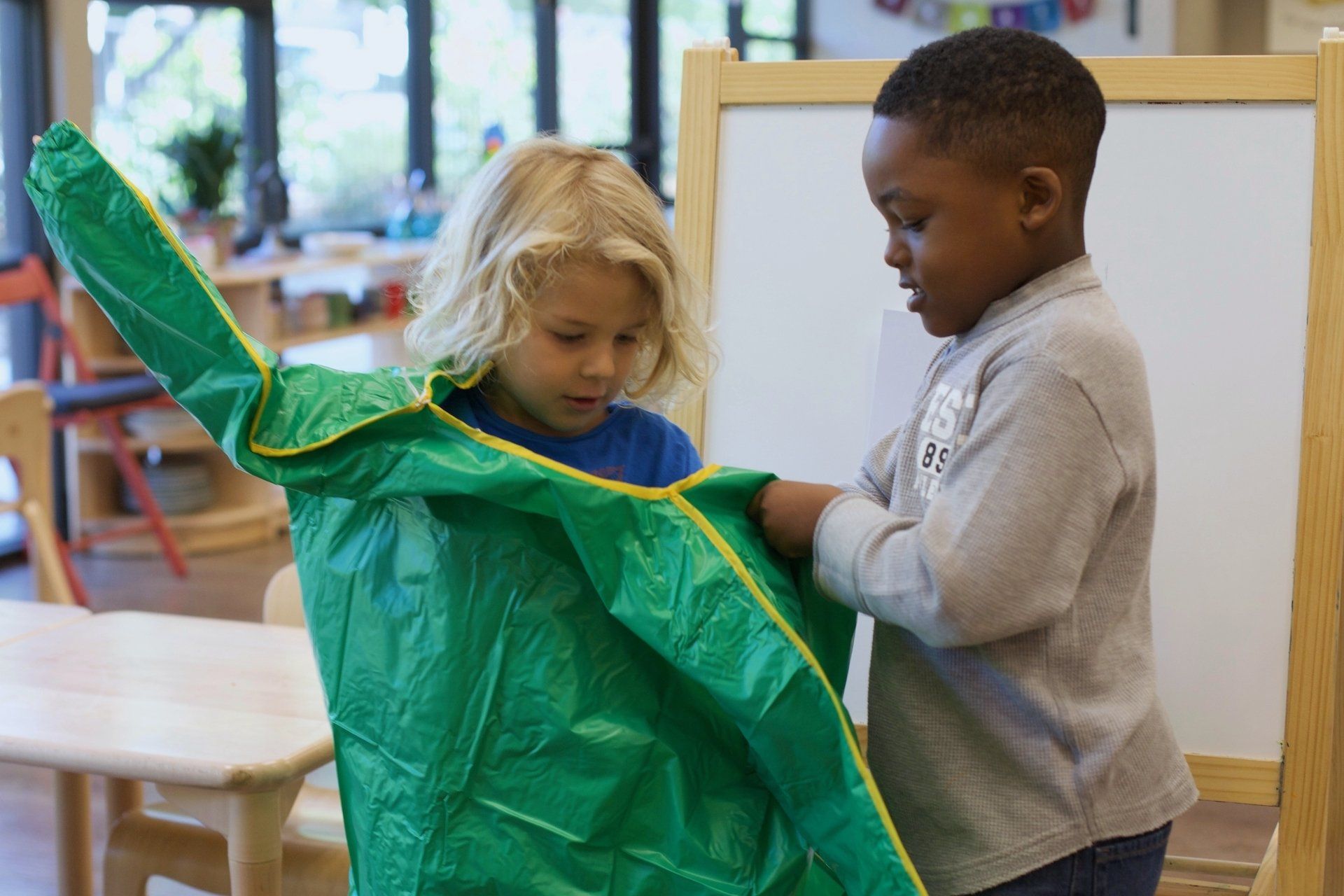Blog Layout
Birthday Books!
Nido Marketing • Feb 06, 2020
We know there isn’t a perfect month to share this book list, but if it’s not your child’s birth month, just bookmark this article for later!
We are always looking for excuses to read new books with our children, and there are plenty of beautifully-crafted birthday books out there. It can be fun to add a new one to your collection each year, or even make a trip to the library together to check out a few. Here are some of our favorites:
Boynton is known for her silly and lovable characters. This book is no exception! Children are delighted by the tale of boisterous monsters whose enthusiasm seems to undermine every fun element of Hippo’s birthday. Just as they leave and it seems everything is ruined, they right zip back in and share a special surprise.
On the Night You Were Born
by Nancy Tillman
We all cherish our children, and Tillman’s book has a way of whimsically and visually showing them how we feel. It begins with: “On the night you were born, the moon smiled with such wonder that the stars peeked in to see you and the night wind whispered, ‘Life will never be the same.’” The name travels on the wind around the world in celebration of the birth of the special child (yours!).
It’s My Birthday
by Helen Oxenbury
From the author of We’re Going on a Bear Hunt, this birthday book will be especially appealing to younger children. A child decides to make a cake for their birthday and enlists the help of friends. A chicken shares some eggs, a bear gets the flour, the cat finds some butter and milk, a pig finds a pinch of salt, and a dog buys some sugar. After a monkey picks some cherries out of a tree, the child has everything they need to bake – and share – the birthday cake.
Happy Birthday Moon
by Frank Asch
Young bear decides it would be nice to get the moon a birthday present. After a (one-sided) conversation echoing from a mountain top, Bear happily returns home, believing that the moon has the same birthday as he does and happens to want the same thing – a hat. The delightful misunderstandings continue, and children will love watching Bear give (and receive) the gift.
The Secret Birthday Message
by Eric Carle
Tim wakes up on his birthday to find an envelope beneath his pillow. A coded message leads him on a treasure hunt for his gift. The pages of this book contain not only Carle’s beautiful signature style of artwork, but there are shaped and cut out pages that make the story a bit more interactive.
Clever Jack Takes the Cake
by Candance Fleming, illustrated by G. Brian Karas
Jack lives in a cottage with his mother, and while they don’t have much, his resilience and generosity are enough to get him through. When he receives an invitation to the princess’ birthday party, he struggles with what he might bring as a gift. Ever-resourceful, he bakes a perfect strawberry cake for her. The journey to the castle is quite an adventure, and while the
cake doesn’t arrive quite as planned, Jack learns that sometimes the best gifts aren’t things at all.
Lyle and the Birthday Party
by Bernard Waber
Loveable Lyle has entertained generations of children. He lives with the Primm family on East 88th Street, and life is generally pretty perfect. When young Joshua’s birthday arrives, however, events take a turn for the worse. Lyle breaks a gift and then wonders if it was actually an accident. This story includes some ridiculous mix-ups, characters dealing with negative
emotions, the love of a family, and the discovery that giving is perhaps more satisfying than receiving.
If a T. Rex Crashes Your Birthday Party
by Jill Esbaum, illustrated by Dasha Tolstikova
Having a T. Rex come to your birthday party might sound like a dream-come-true to many young children, but as the child in this book discovers, it’s not all it’s cracked up to be. The T.Rex is huge, has sharp nails and teeth, and gets pretty grumpy when things don’t go his way. Underneath the tough exterior, however, there’s a gentle heart that will win readers over.
Ling and Ting Share a Birthday
by Grace Lin
The second book in a series about a pair of loveable twins, Ling and Ting Share a Birthday is abook about sharing. These girls are sweet and silly, and they realize that they are lucky to have each other. They share a gift they receive, they shop for one another, they read together…and they celebrate together. This is a perfect book for early readers; it is broken into chapters that
are actually short stories in their own right.
Some Birthday!
by Patricia Polacco
Patricia and her brother live with their mother, but they spend summers with their father and grandmother. One morning, on the day of her birthday, Patricia helps her father get ready for work. He dashes out the door without mentioning it at all. Even when he returns home in the evening, he settles in to read the paper and watch television. Then, out of the blue, he tells the children it would be the perfect night to try and spot the monster at the bottom of the clay pit down the street. He creates a memorable night, ending in the children seeing the “monster”, running home screaming, and realizing he hadn’t forgotten Patricia’s birthday at all! They all celebrate with cake, gifts, and more laughs.
You might also like

19 Sep, 2022
Adolescents exist between two worlds: they are no longer children but they aren’t yet adults. On this bridge to adulthood, adolescents need opportunities to develop real, meaningful, adult-level skills. They aspire to do what adults do. They are curious about how to make their own way in the adult world. As adults, we are part of an economic system. Even if we aren't using money to buy something, through our work or our hobbies we produce or consume aspects of culture. In this way, economics is about the web of interdependence we have with other people. We all depend upon the work and activity of others. Economics and Interactions If we look at economics as how people offer value in their interactions, as well as the production, distribution, and consumption of services and goods, we can really think about economics as how we organize ourselves in society. Because adolescents are building the skills for stepping into the adult world, it’s important to consider how they are developing their ability to navigate this economic aspect of adult life. How many of us had the opportunity, as adolescents, to develop the skills necessary for economic independence? How would our lives be different if, as adolescents, we had a support system so we could Oigure out a fair and reasonable cost for goods we produced, faced the reality of a proOit and loss statement, or found our way in navigating the paths of spending, saving, and sharing? Road to Achieving Economic Independence Dr. Maria Montessori realized the importance of adolescents developing these kinds of skills. In From Childhood to Adolescence, Dr. Montessori made a bold statement about our approach to education and its impact on the greater society. She stated it clearly: “The essential reform is this: to put the adolescent on the road to achieving economic independence.” So in Montessori adolescent programs, we offer our emerging young adults the opportunity to learn key skills of production and exchange. We sometimes call this “microeconomy.” The basic idea is that adolescents need opportunities to produce goods and services, and work with money and monetary systems, so they can develop an understanding and appreciation for how economies work and their own role in economic systems. Real, Meaningful, and Purposeful Work This experience can take many different forms depending upon the community. Whether running a farm stand or a holiday marketplace, adolescents get to learn key skills. They learn to balance proOit and loss. They discuss and determine how much money should be reinvested into the business to help it grow or how much money should be reinvested in the greater community. They respectfully listen to their customers’ needs and concerns and incorporate that feedback in useful ways. In order to have these learning experiences, adolescents need real, meaningful, and purposeful work. Just like young children need to actually prepare food rather than play with a pretend kitchen set, adolescents need actual experiences in creating a business plan, keeping track of income on a spreadsheet, and balancing a budget. They need to practice accounting work so they can build the skills for their own economic independence. They need to have the thrill of handfuls of cash and then face the responsibility of keeping track of those earnings. They need the experience of paying for replacement materials when they have overused key supplies. If they have developed some savings and want to invest the money, they need to Oind opportunities that align with their values. Preparing for Adult Life Too many of our young people enter the world of adult lives without having experienced their role in an economy (perhaps other than being consumers!). Economic independence is a key part of preparing for adult life. We want our adolescents to step into maturity with conOidence that they can independently navigate their new responsibilities and roles. If we give adolescents the opportunity to learn how to have a sound basis for their economic decisions, imagine where they will be when they are adults and making decisions that affect broader aspects of society!

12 Sep, 2022
In their first weeks of life, babies begin to focus their eyes and track objects. These small acts of visual control provide an important foundation for newborns who are building their neural networks. To set infants up for success, we offer a series of specially designed mobiles to aid this development. Each Montessori mobile is created with particular characteristics to help babies further develop their sense of sight, depth perception, concentration, hand-eye coordination, and more. Plus, newborns love them! Essential Characteristics of Montessori Mobiles Montessori mobiles follow a progression that parallels infant development. The first mobiles have a visual focus and begin with basic shapes. They progress to include more complicated objects and eventually become interactive and tactile. The first mobiles are simple and light enough to allow them to flow with gentle air currents. In order for infants to have the best visual experience, a mobile should be hung so that it is about 12 inches in front of them rather than directly above. When babies are lying on their back, there should be a visual line at about a 45-degree angle from their eyes to the mobile. This particular placement allows infants to see the whole mobile moving. Each mobile has visual components designed to help infants track the objects and sharpen their vision. Then after these opportunities to follow objects visually, infants begin to have more arm and hand control and might begin to reach and grasp objects nearby. To support this new ability to reach and grasp, the mobiles take a slightly different form and thus need to be easy to grasp, colorful, and safe for children to mouth. Progression of Mobiles: Visual The first four mobiles–the Munari, Octahedron, the Gobbi, and the Dancers–provide babies with meaningful visual experiences when they are just recognizing shapes and then later identifying colors.

05 Sep, 2022
In Montessori, we talk a lot about independence. However, one of the lesser known or understood aspects of Montessori is that independence isn’t the end goal. As humans, we are each wonderful, unique individuals. But we don’t exist in isolation. We live amongst other wonderful, unique individuals! In order to effectively live in community with other people, though, we need to be able to function independently. Said another way, before we can offer help to others or make ourselves useful, we need to be able to meet our own needs. How can we be independent and interdependent at the same time? We all want to make choices for ourselves, exercise our liberty, and be responsible for our own lives. At the same time, we also want to be part of something. We are designed to be both independent and be in community. These two needs are not mutually exclusive, but in fact, operate in relationship to each other. We have an innate desire to be autonomous and to belong. When we develop the ability to act for ourselves, make choices, control ourselves, and accept responsibility, we are able to be functioning, contributing members of society. We can see what needs doing and do it because we have the skills to do so. We can work with others to create solutions or produce goods and services. We can be part of a community by acting and taking responsibility for our actions, each able to contribute because we all have the skills to do so. What does this have to do with children and Montessori education? From a very young age, children are trying to exert control over their lives. Children are trying to gain functional independence from birth to about age three. In Montessori classrooms, we offer all sorts of opportunities for young children to develop skills that help them take care of their basic needs. But we don’t stop there! We also provide so many ways children can care for others and for their surroundings. Once children have mastered pouring from one pitcher to another, they are able to pour water into a vase and arrange flowers to beautify the classroom. After they learn how to sweep, they are quick to notice a spill and rush to get the dustpan and dust brush so they can help. When someone is struggling to zip their jacket, they take pride in sharing their newfound skill in service to someone else’s need. As children move into the elementary years, this service to others often takes on a slightly different form, in part because elementary-age children are developing their intellectual independence. Thus, their contribution often involves applying these newfound intellectual skills. They might notice a classmate struggling to figure out the steps in a math problem and offer support. Or when friends are in conflict, they might provide some mediation to help each party listen to the others’ perspective. In adolescence, young adults are ready to work toward being socially and economically independent. They want to figure out their place in society, grapple with real problems, and contribute in a useful way. Thus, Montessori adolescent programs offer teens the chance to develop and feel secure in their own abilities while also collaborating in real and meaningful social endeavors. In the process of running a small business, for example, adolescents are applying their intellectual skills from marketing to mathematics, while also navigating how to communicate with customers and collaborate with classmates. Why is this important? As humans, we want to achieve independence and belonging. Being independent is about learning the skills to be able to contribute in a meaningful way. All the little conquests of independence–throughout each age and stage of development–matter! When our infant reaches to grasp an object, our two-year-old demands to put their shirt on themselves, our eight-year-old argues about just and fair rules of a game, or our adolescent insists they can solve a problem with their peers, we can remember that these acts of independence are laying a foundation for our children to become part of an interdependent, harmonious society. Independence is just a step. Interdependence is the ultimate goal.
